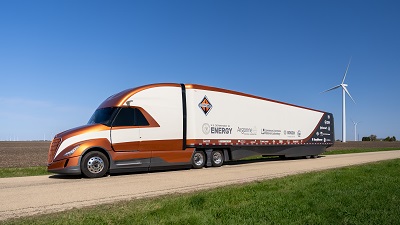News Releases

LISLE, Ill., June 20, 2023 /PRNewswire/ -- Navistar today revealed the results of the International® SuperTruck II, a project in partnership with the U.S. Department of Energy (DOE). International SuperTruck II demonstrates 16 miles per gallon (MPG) fuel efficiency through hybridization and a 170% improvement in freight efficiency, among other advancements over the 2009 baseline vehicle, its International SuperTruck I. It also proves innovative technical approaches to weight reduction from rolling resistance technologies, aerodynamic improvements, and powertrain technologies designed to deliver premium freight efficiency to assist in reducing U.S. dependency on fossil fuels in the commercial vehicle sector.
"With co-funding by the DOE, Navistar engineers experimented with prospective technologies not currently available in the Class 8 truck market to accelerate the impact of sustainable mobility," said Russ Zukouski, chief engineer, Global Innovation and Principal Investigator for the Supertruck programs. "The team concentrated its design on high-voltage electrification, utilizing hybrid technology on a path toward full electrification that has the potential to be commercialized in fully electric vehicles and improve customers' total cost of ownership (TCO) and business operations."
With a shared program goal of increasing Class 8 vehicle efficiency and reducing the U.S. dependance on fossil fuels, International SuperTruck II focused on the next generation of vehicle efficiency improvements through hybridization and aerodynamics. This resulted in a demonstration of 170% improvement in vehicle freight efficiency, 55% engine brake thermal efficiency, assessed TCO opportunities for individual technologies, and high-voltage electrification efforts modeling hybrid technologies that can be utilized for fully electric vehicles.
"Navistar is the only OEM to build a trailer to provide the most accurate testing results possible," said Dean Oppermann, chief engineer, Advanced Truck. "It includes a 100% composite box designed for minimum aerodynamic drag with light weight, integrated cross members, controlled underbody flow with composite aero treatments, next-generation solar panels with connectivity options, and ride height control."
Highlighting Navistar's commitment to an electrified future, International SuperTruck II was built as a hybrid vehicle featuring a combustion engine with high-voltage accessories and technologies, developed in partnership with Bosch. Engine improvements were made in key areas including combustion, friction, gas exchange, and airflow through the engine. A redesigned cylinder head with dual overhead cam engine and enhanced fuel system resulted in a 2% fuel economy improvement when compared to International SuperTruck I. Aftertreatment system improvements included diesel exhausted fluid (DEF) dosing, improved mixing and lower restrictions, new selective catalytic reduction (SCR) formulations for high-NOx reduction and reduced cold-start activation time.
"A full system approach was required to achieve 55.2% brake thermal efficiency," said Jim Cigler, chief engineer, Advanced Engine. "Opportunities were identified by internal engineering teams along with research partner Argonne National Laboratory through detailed analysis and simulation. System suppliers such as Bosch, Jacobs Vehicle Systems, and Applied Nano Systems (ANS) brought new approaches to key systems that enabled laboratory success and yielded real-world fuel economy improvements. Navistar was able to identify new ways to push our engines to the next level of efficiency."
International SuperTruck II highlighted connectivity with next-generation predictive cruise control, as well as leveraging technologies and information within the larger TRATON Group to explore vehicle-to-everything technologies to enhance safety and vehicle efficiencies.
"Our goal is to continue to advance internal combustion engine technology as efficiently and sustainably as possible until there is parity with zero-emissions vehicles," said Opperman. "Development of both technologies concurrently ensures a smooth transition of technology to best serve customer needs. We are focused on the entire product ecosystem – product development itself, as well as infrastructure charging, service and support of vehicle operation, end of life for batteries."
The SuperTruck II program moves Navistar toward its vision to accelerate the impact of sustainable mobility. As a member of the TRATON Group, Navistar continues to identify, engineer, and test future technologies, including solid state batteries, hydrogen fuel cell electric vehicle technology, autonomous driving capability, and connected vehicle solutions.
To see International SuperTruck II in action, visit www.youtube.com/watch?v=tyjZu-TEzX0.
About Navistar
Navistar, Inc. ("Navistar") is a purpose-driven company, reimagining how to deliver what matters to create more cohesive relationships, build higher-performing teams and find solutions where others don't. Based in Lisle, Illinois, Navistar or its subsidiaries and affiliates produce International® brand commercial trucks and engines, IC Bus® brand school and commercial buses, all-makes OnCommand® Connection advanced connectivity services, and Fleetrite®, ReNEWeD® and Diamond Advantage® brand aftermarket parts. With a history of innovation dating back to 1831, Navistar has more than 14,500 employees worldwide and is part of TRATON SE, a global champion of the truck and transport services industry. Additional information is available at www.Navistar.com.
SOURCE Navistar International Corporation


